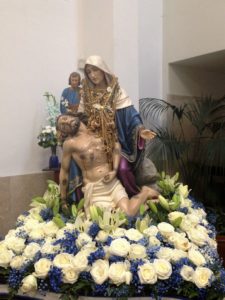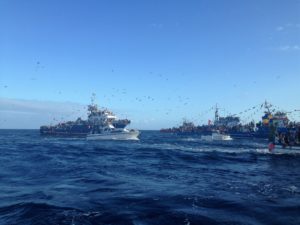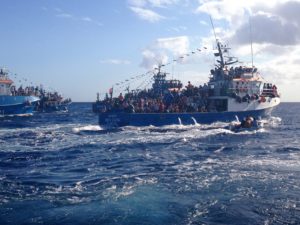
This week we are starting a new category in the blog section of our web site – “Religious Traditions of Madeira”. We will start with an article about the “Festa de Nossa Senhora de Piedade” which takes place on the third weekend of every September, which I took part in the for the first time this weekend (17th – 18th September).
On the Saturday of the feast, the fishing boats proceed in flotilla from the harbour in Caniçal to fetch the statue of Our Lady which resides in the Capela da Senhora da Piedade located on Monte Gordo. This chapel is found some kilometres away from the fishing village of Caniçal. The fishing boats are open to the public free of charge, and hordes of people clamber on to the boats in great spirits to take part in the festivities. The boats are decorated with palms and rosettes, with the lead boat, which is to carry the statue back, more highly decorated than the rest. My friends and I were lucky to get into one of the boats which was not quite so full as some of the others which had standing room only. I must say the excursion is not for the faint hearted!
After some time chugging around the harbour in Caniçal we proceeded on our way to the Quinta de Lourdes. It was a beautiful, sunny day and the sea was very calm. When we reached Quinta de Lourde, all the boats apart from the lead boat proceeded towards the São Lourenço point of the island and then anchored. Sandwiches and cool drinks were handed out free of charge. On some of the boats rope ladders were let down into the sea and people proceeded to dive in. On our boat one lad dived into the sea while the boat was still on the move and was hauled back in when he had finished! The whole event is marked by a happy go lucky attitude rather than strict attention to regulations, although the marine police were actively patrolling on speed boats, in case anyone got into difficulties.
With the statue of Our Lady safely on board we all then proceeded back to Caniçal. The whole excursion lasted about four hours. The statue is taken to the church in Caniçal where it resides overnight and is then taken on the next day back to the Chapel of Senhora de Piedade by sea once again.
This popular feast, and indeed the building of the chapel of Senhora de Piedade , is said to have its origens in a storm at sea when the fishermen at sea, who had been praying to our Lady, decided to build the chapel in thanks for their safe deliverance. According the the historian João Adriano Riberio (author ot the work “Excursions in Madeira (1891)) until the 19th century the procession took place by land and after which the marine procession became popular.




